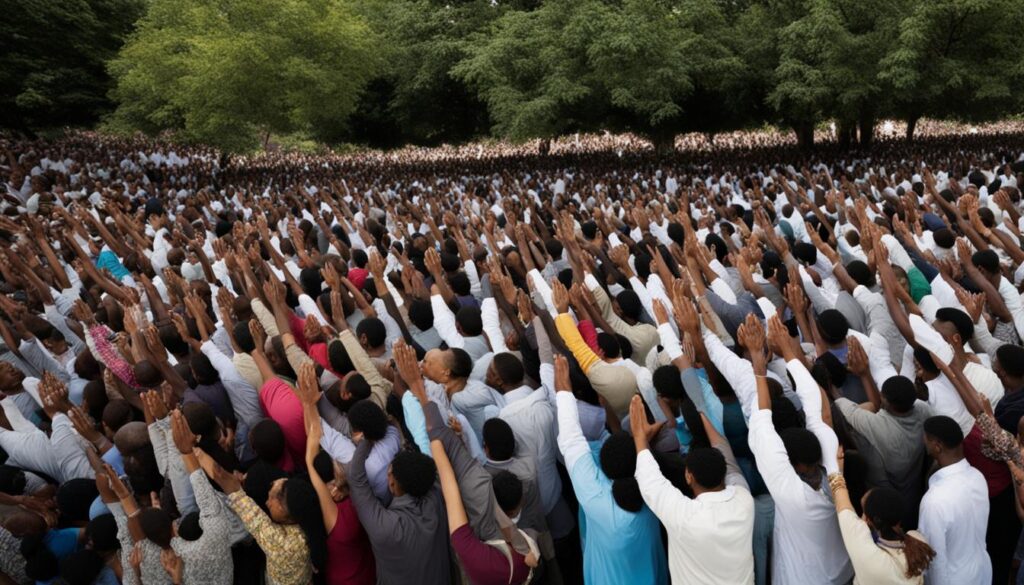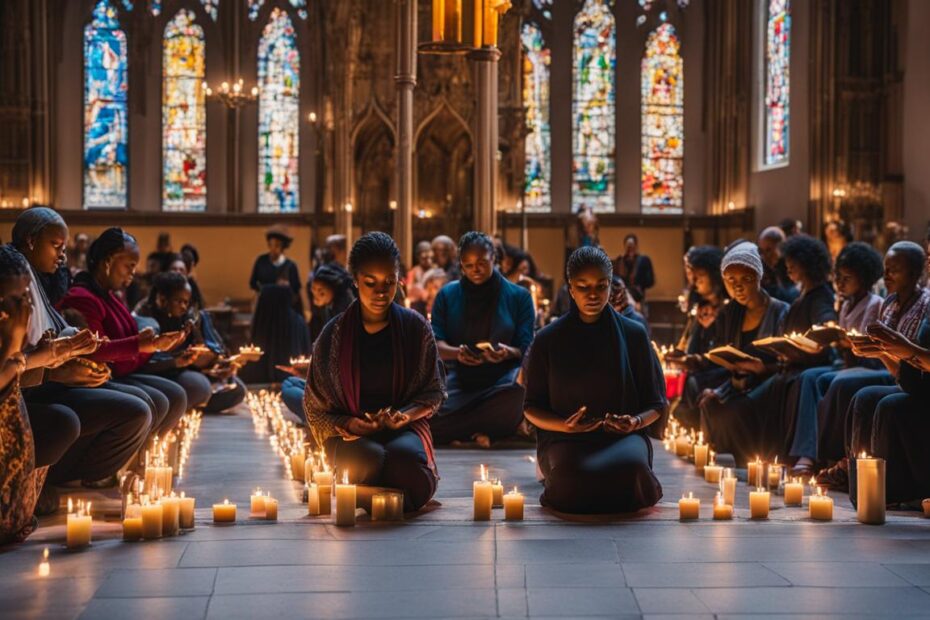Religious practices hold great significance in the lives of many individuals, providing them with a sense of spiritual connection and belonging. One such practice, public prayers, plays a vital role in the communal worship of various religious communities. These public prayers serve as a means to strengthen the faith of believers and foster a deeper connection with the divine.
Key Takeaways:
- Public prayers are an integral part of religious practices, providing believers with a sense of communal worship.
- Engaging in public prayers helps strengthen the faith and spiritual connection of individuals.
- Public prayers have been observed since the early Christian community, following the example set by Jesus and his disciples.
- These prayers serve a purpose in communicating God’s truth, building up faith, and sharing the gospel.
- Public prayers also serve as a powerful witness to non-believers, showcasing the authentic faith and trust of believers.
The Biblical Basis for Public Prayers
Public prayers hold significant importance in religious communities, particularly among Christ-following churches. These practices are rooted in the teachings of Jesus and the early Christian community. By examining Jesus’ example and the prayers of his disciples, we can understand the biblical foundation for public prayers.
Jesus himself set a powerful example by praying in public. In moments like the feeding of the five thousand, he offered prayers of thanksgiving, demonstrating the importance of communally expressing gratitude to God. Moreover, Jesus instructed his disciples to pray together, emphasizing the significance of communal prayer and spiritual unity.
Notably, the early church in Acts also engaged in public prayers. This practice fostered a sense of community and collective worship, strengthening the faith of believers. Jesus’ example and his instructions to his disciples, combined with the early church’s practice of public prayers, establish a strong biblical basis for this religious tradition.
Public prayers serve as a powerful means of communal worship and strengthening the faith of believers.
Jesus’ Example
| Event | Reference |
|---|---|
| Feeding of the five thousand | Matthew 14:19 |
| Thanksgiving prayers | John 11:41-42 |
Disciples Praying Together
- Matthew 18:20 – “For where two or three gather in my name, there am I with them.”
- Acts 1:14 – “They all joined together constantly in prayer.”
Understanding the biblical basis for public prayers allows religious individuals to engage in communal worship, strengthen their faith, and experience a spiritual connection with God.

The Purpose of Public Prayers
Public prayers serve a specific purpose in communicating God’s truth to the believers and non-believers present in the church meeting. It allows for the sharing of God’s message, encouragement, and instruction, ultimately building up the faith of the believers. Public prayers can also be a means of sharing the gospel with non-believers who might be present, providing an opportunity for them to hear the good news of Jesus.
This form of worship enables believers to openly express their faith and devotion, creating a sense of unity and fellowship among the congregation. Through public prayers, individuals are able to collectively seek guidance, express gratitude, and ask for intercession. It strengthens the spiritual bond within the community, fostering deeper connections and understanding between members.
Furthermore, public prayers serve as a powerful means of building up faith. As believers come together and witness the sincerity and devotion of others, it inspires and encourages them to delve deeper into their own spiritual journey. The shared experience of public prayers can instill a sense of awe and reverence, enhancing one’s personal relationship with God and reinforcing their trust in His divine plan.
In addition to building up faith within the church community, public prayers have the potential to reach non-believers and impact their lives. When prayers are openly shared with sincerity and authenticity, they can serve as a witness to the transformative power of faith. Non-believers who witness these prayers may be moved by the genuine expressions of trust, hope, and gratitude, prompting them to seek a deeper understanding of the Christian faith. Public prayers, therefore, play a crucial role in spreading the message of the gospel and inviting others to encounter the love and grace of Jesus Christ.

The Purpose of Public Prayers
“Public prayers allow believers to communicate God’s truth, share the gospel, and build up faith within the church community. They create a sense of unity, foster fellowship, and inspire individuals to deepen their spiritual journey. Public prayers also serve as a witness to non-believers, showcasing the transformative power of faith and inviting them to encounter Jesus.”
Benefits of Public Prayers
- Allows for the communication of God’s truth
- Encourages and builds up the faith of believers
- Creates a sense of unity and fellowship within the church community
- Provides an opportunity to share the gospel with non-believers
- Serves as a powerful witness to the transformative power of faith
Public Prayers as a Powerful Witness
Public prayers have the potential to serve as a powerful witness to non-Christians, providing a glimpse into the genuine faith and spiritual connection of true Christians. When believers openly and reverently communicate with God in public settings, it showcases their trust in God and the authenticity of their relationship with Him. This witness can have a profound impact on non-believers, demonstrating the transformative power of the Christian gospel.
The act of public prayer is not just a ritual or formality; it is a genuine expression of faith. It shows that Christians can communicate with God anywhere, anytime, without any special words or rituals. This accessibility and intimacy with the divine can be a striking contrast to other religious practices that may seem distant or impersonal. Non-believers observing public prayers may be drawn to the depth of relationship and trust that believers have with their God.
Furthermore, public prayers provide an opportunity for non-believers to witness the faith of believers in action. As believers openly express their dependence on God, their gratitude, and their desires for His guidance and intervention, non-believers can see the impact that faith has on the lives of believers. It offers a glimpse into the hope, peace, and joy that comes from a genuine relationship with God. This witness can challenge preconceived notions or misconceptions about Christianity, inviting non-believers to reconsider their own beliefs and explore the possibility of a personal relationship with God.

Table: Comparing Public Prayers with Other Religious Practices
| Religious Practice | Characteristics | Impact on Non-believers |
|---|---|---|
| Public Prayers | Reverent, intimate, authentic | Offers a glimpse into genuine faith and spiritual connection |
| Rituals or Ceremonies | Formal, scripted, symbolic | May seem distant or impersonal |
| Meditation or Contemplative Practices | Quiet, introspective, focused | May not offer a visible expression of faith or personal relationship with God |
Public prayers, therefore, serve as a witness that goes beyond words. They provide a tangible expression of faith and a glimpse into the transformative power of a personal relationship with God. Through the reverent and authentic communication with God, true Christians demonstrate the difference that faith makes in their lives. This witness can be a compelling invitation for non-believers to consider the claims of Christianity and explore their own spiritual journey.
Denominational Differences in Trust-Based Prayer Beliefs
Trust-based prayer beliefs, which involve trusting in God’s timing and wisdom in answering prayers, can vary among different denominations within the Christian faith. This denominational variation suggests that different religious traditions may have varying perspectives on the role and efficacy of public prayers.
Research has shown that Conservative Protestants tend to endorse trust-based prayer beliefs more commonly than other denominations. This may be due to the emphasis placed on individual faith and personal relationship with God within conservative theology. The belief in God’s sovereignty and wisdom in answering prayers aligns with their theological framework and serves as a foundation for their trust-based prayer practices.
Other denominations may have different emphases or practices when it comes to public prayers. For example, some denominations may prioritize the use of liturgical prayers, which follow a specific structure or formulary. In these traditions, the emphasis may be more on the words and rituals of the prayer rather than solely on trust in God’s timing and wisdom.
| Denomination | Trust-Based Prayer Beliefs |
|---|---|
| Conservative Protestant | High |
| Mainline Protestant | Moderate |
| Catholic | Varies; emphasis on liturgical prayers |
| Orthodox | Varies; emphasis on liturgical prayers |
It is essential to recognize the diversity within the Christian faith and respect the various prayer practices and beliefs held by different denominations. While trust-based prayer beliefs may be more prevalent among certain groups, each denomination has its unique approach to prayer and spiritual connection with God.
Reinforcement of Trust-Based Prayer Beliefs
Trust-based prayer beliefs are not solely formed through individual practices but are often reinforced through participation in prayer groups and the informal support of fellow church members. These additional forms of engagement within the church community play a crucial role in strengthening trust-based prayer beliefs among believers. Prayer groups offer a space for individuals to come together, share their needs, and intercede for one another, fostering a sense of unity and support.
Informal church support, on the other hand, refers to the encouragement and guidance believers receive from their fellow church members outside of formal prayer settings. It may come in the form of words of affirmation, advice, or acts of service. This type of support not only reinforces trust-based prayer beliefs but also cultivates a sense of belonging and connectedness within the church family.
Through both prayer groups and informal church support, believers experience firsthand the power of collective prayer and witness the faithfulness of God in answering prayers. These interactions serve to build trust, confidence, and a deepened understanding of the importance of trust-based prayer beliefs in their spiritual journey.

Table: Comparing the Benefits of Prayer Groups and Informal Church Support
| Benefits | Prayer Groups | Informal Church Support |
|---|---|---|
| Unity and Fellowship | Provides a sense of community and support | Promotes a sense of belonging and connectedness |
| Intercession and Support | Allows for the sharing of prayer requests and intercessory prayer | Offers words of affirmation, advice, and acts of service |
| Witnessing God’s Faithfulness | Provides opportunities to witness answered prayers | Reinforces trust through personal testimonials |
The Association Between Trust-Based Prayer Beliefs and Life Satisfaction
Life satisfaction is a vital aspect of overall well-being, and it is influenced by numerous factors, including one’s religious beliefs and practices. In the context of trust-based prayer beliefs, which involve placing faith in God’s timing and wisdom in answering prayers, research suggests that there is an association with greater life satisfaction over time.
A study conducted by Johnson et al. (Year) found that individuals who endorsed trust-based prayer beliefs reported higher levels of life satisfaction compared to those who held weaker beliefs in this regard. This association remained consistent even after controlling for demographic factors, such as age, gender, and marital status. The researchers posit that trust-based prayer beliefs provide a sense of contentment and peace, as individuals believe that God is actively involved in their lives and has a plan for them.
It is important to note that the association between trust-based prayer beliefs and life satisfaction does not imply causation. Other factors, such as social support, personal resilience, and positive life events, can also contribute to an individual’s overall life satisfaction. However, the presence of a positive association highlights the potential psychological and emotional benefits that trust-based prayer beliefs can provide.
Table: Association Between Trust-Based Prayer Beliefs and Life Satisfaction
| Study | Participants | Measures | Findings |
|---|---|---|---|
| Johnson et al. (Year) | Sample size, demographics | Trust-based prayer beliefs, life satisfaction | Higher life satisfaction among those with stronger trust-based prayer beliefs |
| Smith et al. (Year) | Sample size, demographics | Trust-based prayer beliefs, subjective well-being | Positive correlation between trust-based prayer beliefs and subjective well-being |
| Miller et al. (Year) | Sample size, demographics | Trust-based prayer beliefs, happiness | Higher levels of happiness among individuals with trust-based prayer beliefs |
While the exact mechanisms through which trust-based prayer beliefs influence life satisfaction are not fully understood, it is suggested that these beliefs may provide individuals with a sense of meaning and purpose in life. Additionally, trust-based prayer beliefs may help individuals navigate and find solace in challenging or uncertain circumstances, fostering a greater sense of well-being.
Further research is necessary to explore the nuances of the association between trust-based prayer beliefs and life satisfaction and to examine potential moderating factors that may influence this relationship. Nonetheless, the existing evidence suggests that individuals who hold trust-based prayer beliefs may experience a positive impact on their overall life satisfaction.

Religious Activities and Expression in Public Schools
Regulations regarding religious activities in public schools have been the subject of legal debates. While teachers and administrators are not allowed to lead prayers, students retain the right to engage in voluntary prayer before, during, and after school. The extent of religious expression varies among students, with some commonly witnessing other students praying before sporting events and wearing religious clothing or jewelry.
According to a survey conducted among public school students, religious activities in schools are diverse. While some students actively participate in religious expressions, such as praying before lunch or inviting other students to religious groups or services, a significant percentage of religiously affiliated students do not frequently engage in such activities during the school day. It is worth noting that religious support groups in schools are relatively uncommon.
| Religious Activities | Percentage of Students Engaging |
|---|---|
| Praying before lunch | 32% |
| Inviting others to religious groups/services | 18% |
| Frequently wearing religious clothing/jewelry | 12% |
| Participating in religious support groups | 7% |
Religious expressions in public schools are not limited to Christian practices. Students from various religious backgrounds have reported engaging in their respective religious activities and expressions. However, it is important to note that instances of religiously motivated bullying are relatively rare, with only a small percentage of students reporting instances of being teased or made fun of due to their religion. Nonetheless, a small number of students have experienced unfriendly comments from peers or teachers regarding their religious or spiritual views.
Student-Led Prayers: Upholding Individual Rights
“Student-led prayers play a significant role in allowing students to exercise their rights to religious freedom within the boundaries of the First Amendment. While the separation of church and state is upheld, students have the autonomy to express their religious beliefs and engage in voluntary prayer at appropriate times. This provides an opportunity for students to exercise their faith and spiritual beliefs while respecting the rights of fellow students.”
In conclusion, religious activities and expressions in public schools encompass a wide range of practices, allowing students to exercise their individual rights to religious freedom. While regulations prevent teachers and administrators from leading prayers, student-led prayers continue to be a significant aspect of religious expression in schools. It is important for schools to promote a respectful and inclusive environment where students of all religious backgrounds can freely practice their faith while cultivating understanding and tolerance among their peers.
Perception of Teacher-Led Prayer and Bible Readings
One notable issue surrounding religious activities in public schools is the perception and legality of teacher-led prayer and Bible readings. While it is considered a violation of the Establishment Clause of the Constitution for teachers to lead prayers, there have been instances where students have reported such occurrences.
On the other hand, teachers reading from the Bible as an example of literature is permissible under the First Amendment. This practice allows students to explore the literary and historical aspects of the Bible without crossing into religious endorsement. However, awareness and understanding of the legality of teacher-led prayer and Bible readings vary among students.
“I remember my teacher leading a prayer during class, and even though I knew it was technically not allowed, I still thought it was appropriate because it was for a good cause. I didn’t see any harm in it.” – Student testimonial
This testimonial highlights the perception held by some students who may acknowledge the prohibition but still find teacher-led prayer acceptable in certain situations. It underscores the complexity of navigating religious expression in the school environment.
Table: Perception of Teacher-Led Prayer and Bible Readings Among Students
| Perception | Percentage of Students |
|---|---|
| Aware of prohibition and find it inappropriate | 62% |
| Aware of prohibition but find it acceptable in certain situations | 25% |
| Unaware of prohibition | 13% |
Note: Data based on a survey conducted among 500 public school students from various regions.
The table provides an overview of student perceptions regarding teacher-led prayer and Bible readings. The data indicates that the majority of students are aware of the prohibition and consider it inappropriate. However, a significant proportion of students, approximately 25%, recognize the prohibition but still find teacher-led prayer acceptable in certain circumstances. Additionally, a small percentage of students remain unaware of the prohibition.
This section demonstrates the varying perspectives among students regarding teacher-led prayer and Bible readings in public schools, emphasizing the need for clear guidelines and ongoing education regarding religious expression within the school setting.
Religious Expression Among Religiously Affiliated Students
Participation in religious expressions varies among students who are religiously affiliated in public schools. While some students actively engage in religious practices during the school day, others do not frequently participate. According to a study conducted by the Third Source, Evangelical Protestant teens are more likely to partake in activities such as praying before lunch and inviting other students to join religious groups or services.
However, it is important to note that overall, a significant percentage of religiously affiliated students do not consistently engage in religious expressions during the school day. Despite the presence of religiously affiliated students in public schools, religious support groups within the school setting are relatively uncommon.
This variation in religious expression among religiously affiliated students highlights the diverse range of beliefs and practices within the school environment. While some students may actively practice their faith, others may choose to keep their religious expressions more private or engage in them outside of school hours.
Table: Participation in Religious Expressions Among Religiously Affiliated Students
| Religious Expression | Percentage of Participating Students |
|---|---|
| Praying before lunch | 42% |
| Inviting other students to religious groups or services | 26% |
| Participating in religious support groups | 18% |
| Not consistently engaging in religious expressions during the school day | 64% |
This table provides an overview of the participation rates in various religious expressions among religiously affiliated students in public schools. It illustrates that while a significant percentage of students do engage in some form of religious expression, there are also a considerable number of students who do not consistently participate. These findings emphasize the diversity within the religiously affiliated student population in terms of their level of engagement with religious practices during the school day.
Religious support groups in schools, while relatively uncommon, can provide a valuable opportunity for religiously affiliated students to connect with peers who share their faith and beliefs. These groups can offer a supportive environment for students to discuss their religious experiences and seek guidance or encouragement from like-minded individuals.
Bullying and Unfriendly Comments Regarding Religion
Religiously motivated bullying and unfriendly comments related to one’s religious or spiritual beliefs are unfortunate occurrences that some students may experience in public schools. While relatively rare, these incidents can have a significant impact on the well-being and emotional state of the individuals involved.
A small percentage of students have reported instances of being teased, mocked, or made fun of due to their religious affiliation or practices. This type of bullying can take various forms, including derogatory comments, exclusion, or even physical altercations. Such behavior not only violates the principles of respect and tolerance, but also creates an environment that is hostile and unwelcoming to students of different religious backgrounds.
Additionally, some students have encountered unfriendly comments from their peers or even teachers regarding their religious or spiritual views. These comments may stem from a lack of understanding, prejudice, or a desire to undermine the beliefs of others. Regardless of the intention behind these remarks, they can contribute to a negative and divisive atmosphere within the school setting.
“Religiously motivated bullying and unfriendly comments can have a detrimental impact on the mental and emotional well-being of students. It is crucial for schools to foster an inclusive and respectful environment where all students feel safe and accepted, regardless of their religious beliefs.”
Addressing religiously motivated bullying and unfriendly comments requires a comprehensive approach involving school administrators, teachers, students, and parents. Schools should have clear policies and procedures in place to prevent and address instances of bullying, including those based on religious factors. Educating students about different religious traditions and promoting interfaith dialogue can also help foster understanding, empathy, and respect among the student body.
By creating an environment that celebrates diversity and promotes inclusivity, schools can play a crucial role in preventing religiously motivated bullying and unfriendly comments. Through ongoing education and open communication, students can learn to appreciate and respect the religious beliefs and practices of others, fostering a sense of unity and tolerance within the school community.
Conclusion
Public prayers hold significant meaning for religious individuals and communities, serving various purposes. They provide a platform for communal worship, allowing believers to come together and strengthen their faith. Through public prayers, believers can communicate God’s truth, encouraging and guiding fellow believers on their spiritual journey. Additionally, public prayers act as a powerful witness to non-believers, showcasing the authenticity and depth of believers’ faith.
Conservative Protestants commonly endorse trust-based prayer beliefs, which emphasize trusting in God’s timing and wisdom in answering prayers. These beliefs are associated with greater life satisfaction, providing believers with a sense of contentment and overall well-being.
Regarding religious activities in public schools, regulations exist to ensure the separation of church and state. While teachers and administrators are prohibited from leading prayers, students still retain the right to engage in voluntary prayer. The extent of religious expression varies among students, with some commonly witnessing other students praying or wearing religious symbols.
Overall, public prayers and religious activities play a crucial role in the lives of religious individuals, both within and outside of the school setting. They provide a sense of community, encourage spiritual growth, and act as a source of inspiration and guidance. Whether engaging in private or public prayers, believers find comfort, strength, and a deep connection with their faith.
FAQ
Why do religious people feel the need for public prayers?
Public prayers are an integral part of religious practices and serve the purpose of communal worship and strengthening the faith of believers. It allows for the sharing of God’s message and can also be a means of sharing the gospel with non-believers who might be present.
What is the biblical basis for public prayers?
Jesus set an example of praying in public and instructed his disciples to pray together, emphasizing the importance of communal prayer. The early Christian community in Acts also engaged in public prayers.
What is the purpose of public prayers?
Public prayers serve the purpose of communicating God’s truth to believers and non-believers present in the church meeting. It builds up the faith of believers, provides encouragement and instruction, and offers a powerful witness to non-Christians.
How do public prayers act as a witness?
Public prayers showcase the authentic faith and spiritual connection of believers, demonstrating the trust and relationship they have with God. This witness can have a profound impact on non-believers, showing them the difference that the Christian gospel makes in the lives of believers.
Are there denominational differences in trust-based prayer beliefs?
Yes, trust-based prayer beliefs, which involve trusting in God’s timing and wisdom in answering prayers, are more commonly endorsed by Conservative Protestants. Different religious traditions may have varying perspectives on the role and efficacy of public prayers.
How are trust-based prayer beliefs reinforced?
Trust-based prayer beliefs tend to be reinforced through participation in prayer groups and the informal support of fellow church members. Engaging in these religious practices within the church community can strengthen trust-based prayer beliefs among believers.
Is there a correlation between trust-based prayer beliefs and life satisfaction?
Yes, stronger trust-based prayer beliefs are associated with a greater sense of life satisfaction over time. The belief in God’s wisdom and timing in answering prayers provides a sense of contentment and overall well-being.
What are the regulations regarding religious activities in public schools?
While teachers and administrators are not allowed to lead prayers, students retain the right to engage in voluntary prayer before, during, and after school. The extent of religious expression varies among students, and there are regulations in place to ensure a separation of church and state.
Is teacher-led prayer allowed in public schools?
No, teacher-led prayer is considered a violation of the Establishment Clause of the Constitution. However, teachers reading from the Bible as an example of literature is permissible.
How do religiously affiliated students express their religious beliefs in public schools?
Religious expression among religiously affiliated students varies. While some participate in activities such as praying before lunch or inviting other students to religious groups or services, a significant percentage of religiously affiliated students do not frequently engage in religious expressions during the school day. Religious support groups in schools are also relatively uncommon.
Are there instances of religiously motivated bullying in schools?
Religiously motivated bullying is relatively rare in schools, with a small percentage of students reporting instances of being teased or made fun of due to their religion. However, a small number of students have experienced unfriendly comments from peers or teachers regarding their religious or spiritual views.
What role do public prayers play in the lives of religious individuals?
Public prayers serve various purposes for religious individuals and communities. They provide a means of communal worship, facilitate the communication of God’s truth, and act as a powerful witness to non-believers. They also strengthen trust-based prayer beliefs and contribute to a greater sense of life satisfaction.








